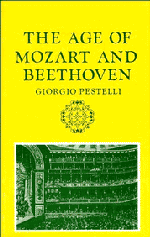Author's note
Published online by Cambridge University Press: 10 November 2010
Summary
The present volume contains more and less than the title suggests. More because the account starts from the death of Bach (1750) and therefore includes phenomena and composers that were born and grew up before Mozart, like the galant style, Gluck, C. P. E. Bach and Haydn. Less because there are only passing references here to figures such as Weber, Rossini and Schubert, whose activity, within a year or two, would strictly have to be included in the chronological confines of a ‘Beethovenian age’. The presence of these ‘contemporaries of Beethoven’ within the following pages, however, apart from removing their names from books devoted to nineteenth-century Germany and Italy, would have meant an intolerable size for a volume which, as it is already, has greatly exceeded its original plan.
I have not used the terms ‘classical’, ‘classical style’ or ‘classicism’, although they are frequently used to describe the period dealt with here (what would the gap left unfilled between Bukofzer's ‘Baroque Era’ and Einstein's ‘Romantic Era’ in Norton's famous history be called, if not the ‘Classical Era’?); and it is certainly not out of lack of interest in the historiographical and stylistic concepts and all the problems that their definition carries with it, but rather because I considered that those terms were not very useful for an approach that intended to be essentially historical.
- Type
- Chapter
- Information
- The Age of Mozart and Beethoven , pp. viii - ixPublisher: Cambridge University PressPrint publication year: 1984



